Iguazu Falls 3-Day Itinerary + FAQs for Planning Your Trip (Visiting both Brazil and Argentina sides)

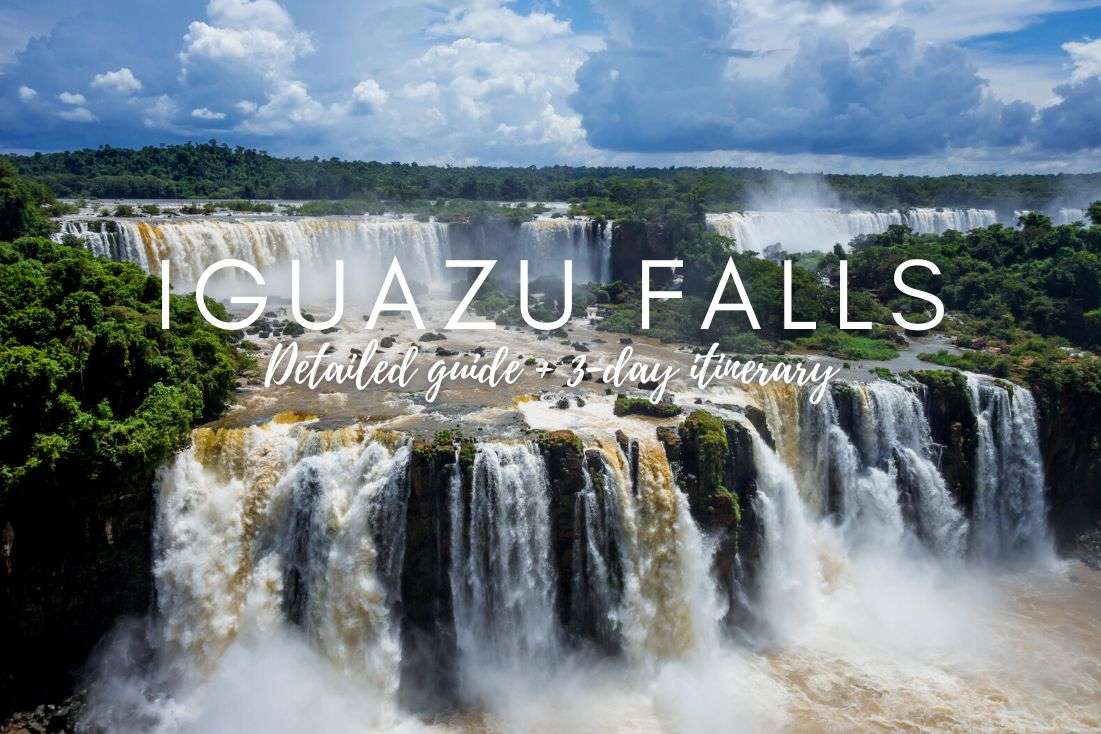
Honestly, I am not that much into waterfalls. I find them kind of interesting, but not too interesting and I thought I saw some big falls like Shoshone Falls in Idaho or Yellowstone in Montana. They are big, but boy I was wrong thinking Iguazu would be just another big waterfall. Iguazu is absolutely massive! I have seen a lot of places, but Iguazu Falls is unbelievable.
Just walking around will take you hours and that excludes all the extra stuff like helicopter trips or boat trips under the falls. Combine that with a very pleasant tropical/subtropical climate and a very green jungle with a big city near the falls and you get a fantastic trip destination.
I've put together a no-bullshit guide for a 3-day Iguazu visit (4 if you want to rest a bit too). I am fast at traveling, and I am telling you, you’re going to use all of those 3 days pretty fully. Then, I’ve added answers to the top 12 FAQs about going to Iguazu, like which side is better, how to get there, the costs, and if that helicopter ride is worth it.
What to expect at Iguazu Falls
Let's start from scratch. Iguazu Falls, located right on the border between Argentina and Brazil, forms the largest waterfall system in the world. It has secured its spot among the seven new natural wonders of the world, and, of course, it's a UNESCO World Heritage site (and rightly so, if you ask me). The falls stretch over the Iguazu River, spanning approximately 2.7 km (1.7 mi) in width.
You can access them from either side—Brazil or Argentina. The Iguazu Falls are part of Iguazu National Park (near Puerto Iguazu) in Argentina and Iguaçu National Park (near Foz de Iguaçu) in Brazil, both of which are UNESCO World Heritage sites. It is customary to visit the falls from both sides during a single visit (usually over 2 days).
Each side offers a totally different experience. On the Argentine side, you'll feel like you're right in the midst of the falls, while the Brazilian side provides breathtaking views. And here's a little tidbit from the Brazilian side: not only does everyone speak English, but all the signs are in English too, which is super cool. Overall, the Brazilian side is ultra-organized.
The number of waterfalls fluctuates with the seasons. During the rainy season (October–March), the river's flow can reach up to 6,500 m³/s (229,545 ft³/s), creating around 270 cascades. In contrast, the drier months (May–September) see a decrease in water volume, with flow rates dropping to about 300 m³/s (10,594 ft³/s), leaving roughly "just" 150 waterfalls.
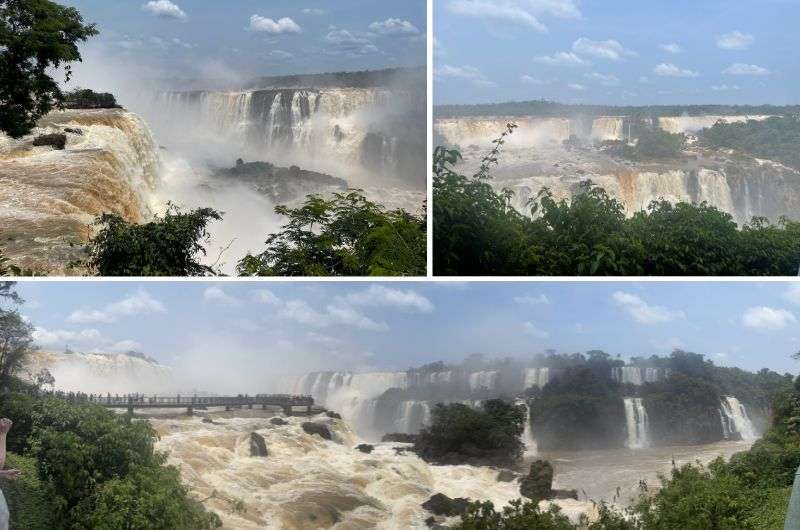
Iguazu Falls are truly gigantic
The most famous among these is the so-called "Devil's Throat" (Garganta del Diablo). Once you see it for yourself, you'll agree the name couldn't be more fitting. It's the largest of the Iguazu Falls, spanning about 150 m (492 ft) in width and 82 m (269 ft) in height. These might just seem like numbers, but trust me, it's colossal. Just imagine the sheer volume of water thundering down into a narrow canyon, surrounded by towering cliffs and rock formations.
A quick language note: In Portuguese, the falls are called "Cataratas do Iguaçu," and in Spanish, "Cataratas del Iguazú."
So, that's a brief intro to get you acquainted with what you're about to experience. Next, I'll provide you with a detailed three-day itinerary to ensure you see and experience the best of Iguazu Falls. And don't forget to check out the FAQ section, where I'll answer all your burning questions.
Overview of your 3-day Iguazu Falls itinerary
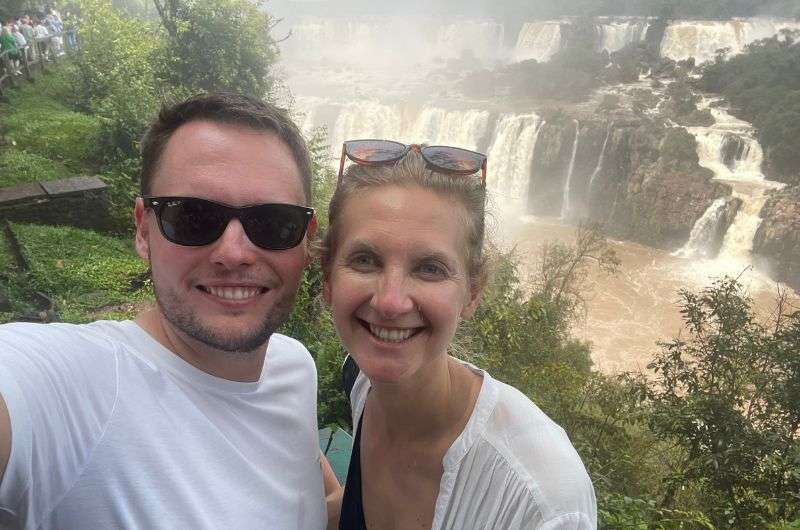
3 days of watching the spectacular Iguazu Falls really imprinted into my memory
Here's a detailed plan for your 3-day Iguazu Falls itinerary. Theoretically, you can manage to visit the falls in two days, so if you're pressed for time, feel free to shorten it to a 2-day Iguazu Falls itinerary. I've added extra sightseeing on the third day just in case you didn't get enough or didn't manage to explore everything in the previous two days, giving you the chance to revisit the falls.
Day 1: Iguazu Falls Brazil side (helicopter flight, boat&safari tour, hiking trail)
Day 2: Iguazu Falls Argentina side (Upper Circuit, Lower Circuit, Macuco trail)
Day 3: Iguazu Falls Argentina side + extra things to see (Landmark of the 3 borders, La Casa de Botellas, La Aripuca, Jardín de los Picaflores)
My quick tips for visiting Iguazu Falls:
- Don't get too hyped up about the 'safari tour'—it's a tad on the snoozy side, if I'm honest. 'Safari' is a bit of a stretch here. You're more or less traipsing through the jungle to get to the dock where the real fun begins.
- Bring a raincoat, but honestly, it's more of a feel-good accessory. Raincoats are meant for rain, not for getting drenched as you zip through waterfalls three times over.
- You’ll need sharp elbows! If you're aiming for a decent view from the helicopter, you better snag that window seat. That's right, it's all about timing—be the first or the last to hop on.
Day 1 of Iguazu Falls itinerary: Brazil side
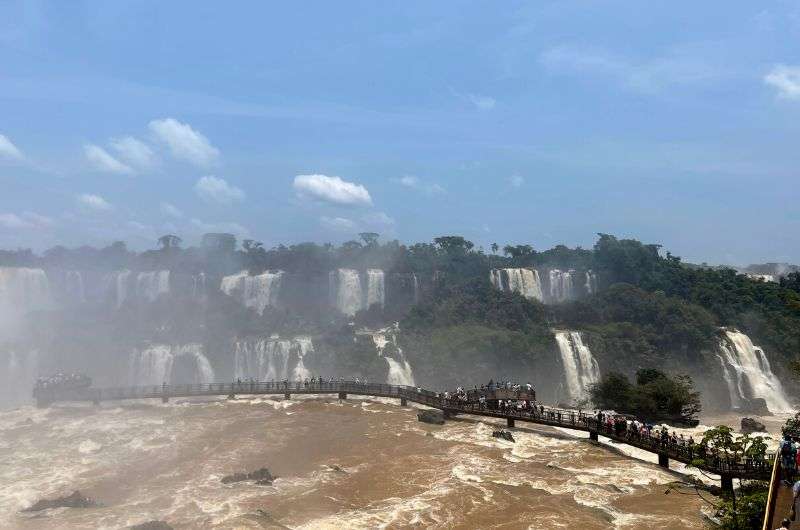
The Brasilian side of Iguazu Falls
Main sites visited on day 1: Helicopter tour, Boat&safari tour, hike
Restaurant tips: Jungle Restaurante–Puerto Iguazú
Hotel recommendations: Loi Suites Iguazu Hotel
Distance from Loi Suites Iguazu Hotel: 29 km (18 mi), 57-minute drive
Time spent there: All day (8 am–6 pm)
We stayed on the Argentinian side (and I advise you to do the same, see FAQ 7 below) at Loi Suites Iguazu Hotel. We set out before 8 am because the drive to the park takes about 20 minutes, the park opens at 8 am, and we wanted to avoid the queues as much as possible. I recommend taking a taxi, which your hotel can easily arrange for you. At the park, you buy a ticket for about BRL 100 (USD 20) for a specific time to board the bus, and then you have the whole day to explore the park.
Tip: If you’re on a tight schedule and decide to blitz through Iguazu Falls in one day, definitely head out at opening time. You're constantly waiting for something, transferring somewhere, and it all stretches out the experience.
Day 1, stop 1: Helicopter tour
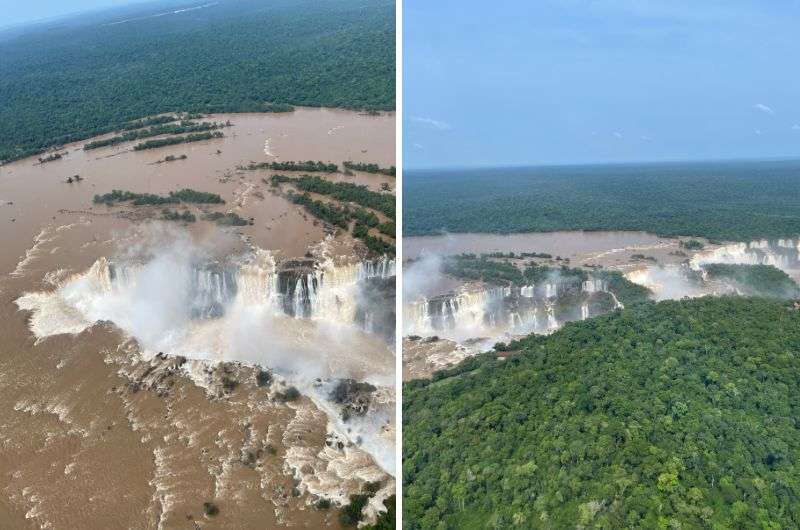
Try to get a window seat on the helicopter to fully enjoy these spectacular views—boarding first or last is your best bet
First, I'd head for a helicopter tour over the falls because the queues build up in the afternoon. It also seems good to see the falls from a broader perspective first, to get a better idea of their size. Although they don't look that big from the helicopter, when you get closer, it's absolutely mind-blowing. The whole thing is a beautiful sight, including the surrounding rainforest.
No need to sweat over booking the helicopter tour in advance; just show up, fork over the cash, cool your heels for about half an hour, and boom, you're airborne. Seriously, it's a no-brainer experience (I spill more beans in FAQ 9 below). Just try to board the helicopter first or last, then you'll be by the window and have an excellent view.
- Official website of Helisul
- Tickets: BRL 610 (USD 145) per person
Day 1, stop 2: Boat&Safari tour
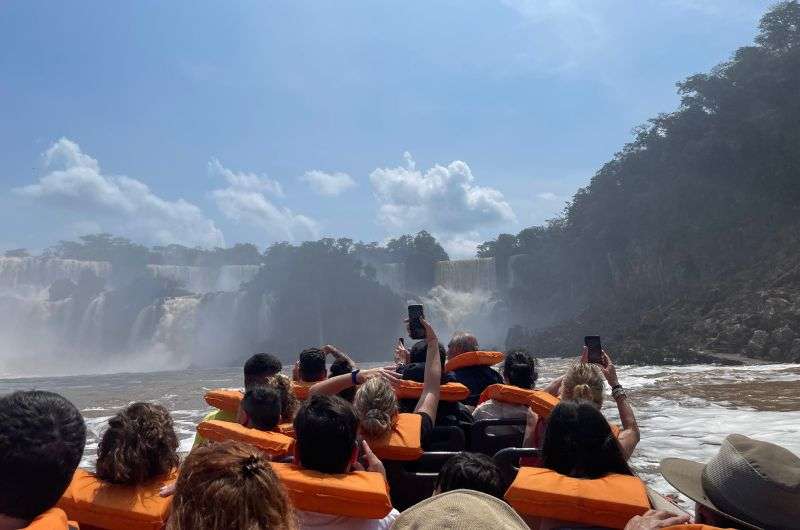
The boat tour is a must!
The next adventure, or better said, a thrilling ride, is by boat, bringing you right to the falls. Grab your boat tour tickets at the national park entrance—no pre-planning needed. Board the bus and hop off at the first stop (or second if you're coming from the falls)—you're aiming for the Macuco Safari station. And trust me, it's foolproof, plus you're smack in the midst of lush jungle vibes. Super cool! If buses aren't your thing, you could theoretically trek from the falls to the station.
At the stop, a guide awaits to lead you to an open-air tram for a jungle jaunt. Then you'll disembark for a 20-minute jungle walk to the dock, where your aquatic adventure begins. Stash your non-waterproof belongings in lockers, don your life jacket and raincoat.
Good to know: Be prepared to get soaked! We plunged right into the falls three times during the voyage. Absolutely exhilarating.
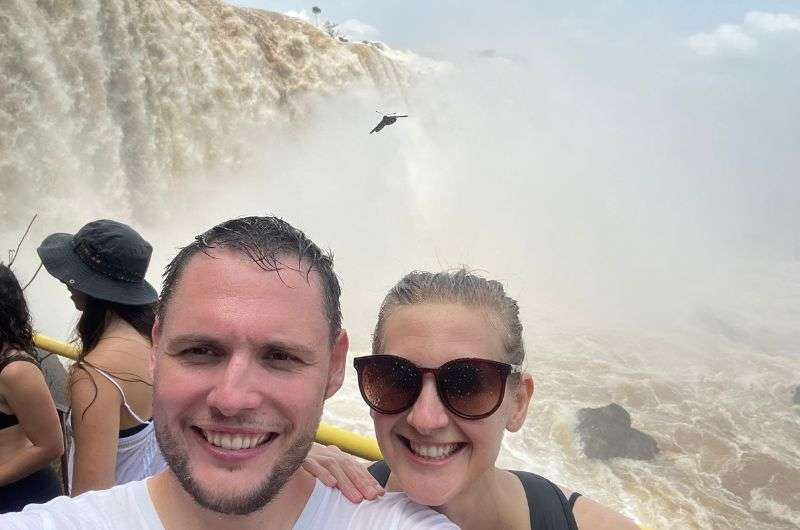
Yep...get ready to get soaked!
The boat journey lasts about 30 minutes. Don't expect to sail into Garganta del Diablo, though. But on your way, you'll navigate through rapids—thrilling! The boats are beasts, packing 2x300 horsepower. It's the closest you'll get to the falls, offering a totally different perspective than viewing from above.
My further insights about the Iguazu boat tour:
- Kids of all ages can join the boat fun; there's no age limit.
- Be ready to wait: first when boarding the tram, then the boat. Thus, the whole Boat & Safari tour stretches to about 2 hours, though it would otherwise only be about an hour.
- You can opt for a private tour, which we would've jumped on had we known.
- Skip the sunscreen; post-boat ride, you'll feel like you just climbed out of a pool, and the last thing you want is stingy eyes from the lotion. It’s also a good idea to swap your glasses for contact lenses unless you want them to fly off into the waterfalls.
- Tickets cost around BRL 380 (USD 76 per person)
Day 1, stop 3: Hiking trail Brazil side
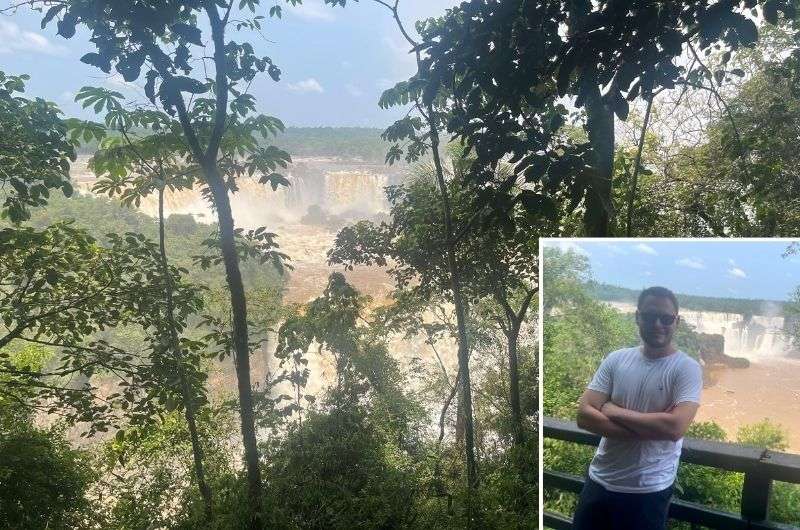
Hiking through the rainforest enjoying amazing Iguazu Falls views
Hike length: 3.2 km (2 mi)
Elevation gain: 110 m (361 ft)
Difficulty level: Easy
Hiking time: 1 hour
Trailhead: Google Maps link to trailhead
Now, let's switch gears from various modes of transport to your own two feet. The Iguazu jungle is exactly how I imagined the Amazonia: dense, wet, and wildly lush—a stark contrast to the woods of Calilegua National Park. We lucked out with a comfy 31°C (88°F) but brace yourself; it can skyrocket to a sizzling 47°C (117°F). I can't even imagine that! Plus, we hit the jackpot with the water flow being ten times its usual rate.
It's a lovely walk through the rainforest with stunning views of the waterfalls. You walk over bridges above the falls, which seem just barely safe enough, but hey, YOLO! And expect to get wet. Reaching the end at the Alberto Santos Dumont Memorial, you'll find a raised platform offering a splashy experience courtesy of the nearby cascade—quite a welcome cooldown in the heat.
Each fall could be a standalone attraction elsewhere, but here, they're all spectacularly bundled together. While the Brazilian side offers stunning panoramic views, you'll also encounter a variety of wildlife here—coatis, monkeys, capybaras, lizards, turtles, and loads of birds, including toucans. The more time you spend, the higher your chances of wildlife encounters. Though jaguars and pumas call this place home, thankfully, we didn't bump into any.
A heads-up: Don't expect solitude on these trails. It's more like you plus thousands of your closest tourist friends, especially at the Devil's Throat, where things can get a bit cramped.
If you find yourself hungry after your adventure, there's Restaurante Porto Canoas waiting for you at the end of your trail. Operating buffet-style, its main perk is the dining-with-a-view experience, allowing you to gaze at the falls while enjoying the food. We didn't get to try it, so I can't personally vouch for the grub there. However, I can wholeheartedly recommend Jungle Restaurante – Puerto Iguazú. Their food is downright amazing. The local surubí (catfish) we had was delicious, and unlike other Argentine eateries, they give you a large portion of meat. The service was average, and prices on the higher side, but trust me, the culinary delight is totally worth it.
Map of the Iguazu Falls hike on Brazil side. See route details on Alltrails
Day 2 of Iguazu Falls itinerary: Argentina side
Main sites visited on day 1: Upper Circuit, Lower Circuit, Macuco Trail
Restaurant tips: Jungle Restaurante–Puerto Iguazú
Hotel recommendations: Loi Suites Iguazu Hotel
Distance from Loi Suites Iguazu Hotel: 21 km (13 mi), 30-minute drive
Time spent there: All day (8 am–6 pm)
On the second day, you'll be heading to the Argentine side of Iguazu Falls. This side is where you’ll find a larger number of the falls, allowing you to get up close for a completely different experience. Plus, Argentina offers a wider array of hiking trails for you to choose from. They all start from Estación Cataratas, apart from the Devil’s Throat trail that was, unfortunately, closed when we went.
Important! Just like on the Brazilian side, you'll need to purchase a ticket. But you have to buy your ticket online in advance for the Argentine side. The price is ARS 20,000 (USD 24), and you'll need to choose a specific time due to the bus schedule. I highly recommend getting there right at opening time (8 am) to visit the most popular spots before they get swamped with other tourists.
In addition to the hiking trails, the Argentine side offers another boat tour that takes you right up to the waterfalls. We had already taken the boat tour on the Brazilian side, so we decided to skip it in Argentina.
Day 2, stop 1: Upper Circuit, Argentina side
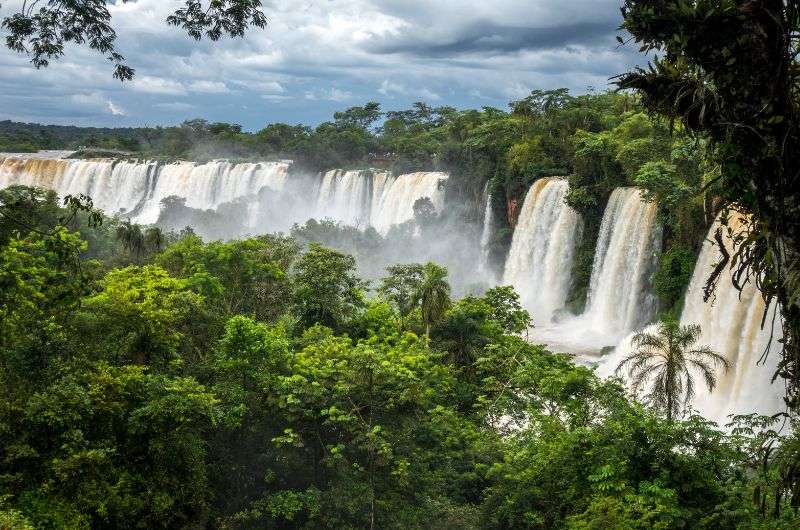
Walking above the Iguazu Falls
Hike length: 2.4 km (1.5 mi)
Elevation gain: 47 m (154 ft)
Difficulty level: Easy
Hiking time: 30 min
Trailhead: Google Maps link to trailhead
Alright, let's kick off your adventure at Estación Cataratas station, where the Ecological Train, your leisurely chariot, awaits. It's on the house and cruises at a snail's pace, perfect for soaking in the lush vibes around you.
The trail unfolds on a metal pathway, offering a breezy walk sprinkled with benches. Good luck claiming one, though—they're like hotcakes, always snapped up by someone else. As you meander, there are six lookout points where you can pause and drink in the spectacular views of the falls. Trust me, you're getting up close and personal with the cascades here, way closer than on the Brazilian side. You're practically hovering above them!
Map of the Iguazu Falls hike on Argentina side—Upper Circuit. See route details on Alltrails
Day 2, stop 2: Lower Circuit, Argentina side
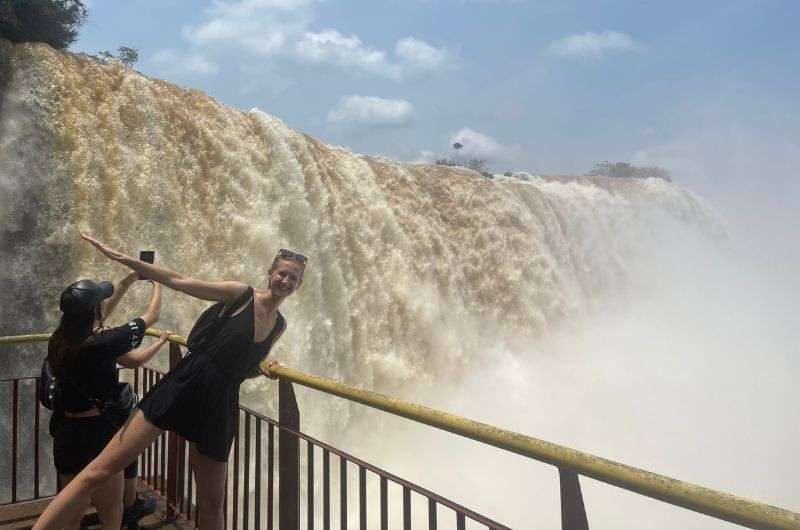
From below, Iguazu Falls are even more epic
Hike length: 2.9 km (1.8 mi)
Elevation gain: 108 m (354 ft)
Difficulty level: Easy
Hiking time: 50 min
Trailhead: Google Maps link to trailhead
The Lower Circuit starts at the same spot as the Upper Circuit. It's a tad longer, but if I had to pick one, I'd definitely recommend the lower one. Why? It gives you those killer panoramic views. When you're beneath the waterfalls, they seem even more gargantuan than from above.
And just like before, you're walking on metal walkways 90% of the time, making the trek pretty chill. Just a heads-up: it's noticeably hotter here than on the Upper Circuit.
Map of the Iguazu Falls hike on Argentina side—Lower Circuit, to get you to the best view. See route details on Alltrails
Day 2, stop 3: Macuco Trail
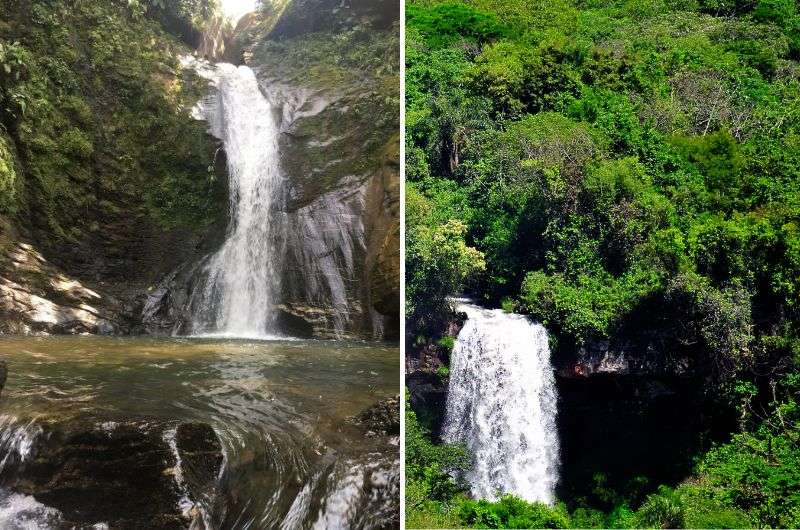
Macuco trail
Hike length: 7.6 km (4.7 mi)
Elevation gain: 103 m (338 ft)
Difficulty level: Moderate
Hiking time: 1.5 hours
Trailhead: Google Maps link to trailhead
The trek again kicks off at Estación Central, and guess what? You're hopping on that Ecological Train again. This hike isn't your typical half-hour stroll. The terrain's a bit more challenging, but if you're itching to trace the local fauna's footsteps and really soak in the wilderness, you’ll love it. The trail carves through the wild jungle, so you’ll certainly spot some of the local critters. We saw a bunch of monkeys (okay, like five) and also butterflies, lizards, and ants. That might sound a tad boring, but those ants were seriously massive!
The Macuco Trail isn’t as popular as the other two trails, which is great, because that means way fewer people (finally)! And as a sweet bonus, at the end of the trail, you'll be treated to a view of Salto Arrechea—a waterfall with a natural pond.
Map of the Iguazu Falls hike on Argentina side—Macuco Trail. See route details on Alltrails
Day 2, stop 4: The Devil's Throat
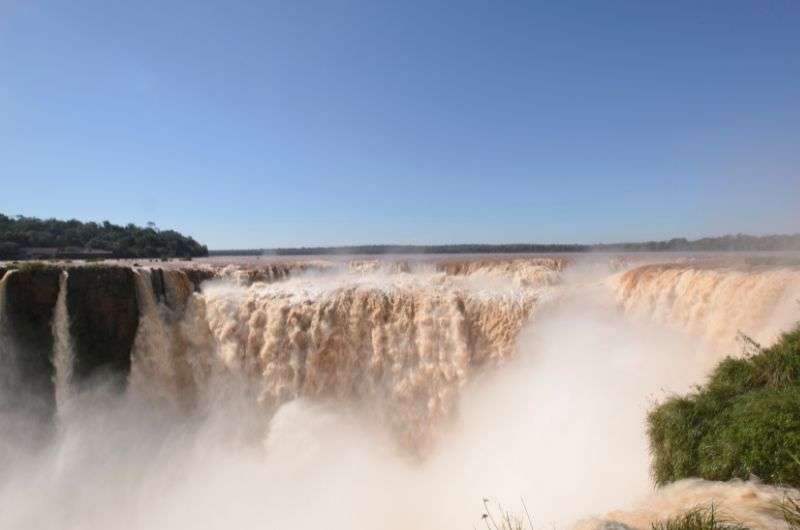
And finally, the Devil’s Throat
Hike length: 2.1 km (1.3 mi)
Elevation gain: 17 m (56 ft)
Difficulty level: Easy
Hiking time: 45 min
Trailhead: Google Maps link to trailhead
The Devil's Throat is one of the most popular hikes on the Argentine side. Unfortunately, during our visit, the trail was closed, and it looks like it will remain closed throughout 2024. A massive rise in water levels significantly damaged the walkways that lead to the viewpoint. So, quite a bit of bad luck there.
Map of the Iguazu Falls hike on Argentina side— The Devil's Throat hike, which is unfortunately closed in 2024. See route details on Alltrails
Day 3 of Iguazu Falls itinerary: Argentina side again + extra things to see
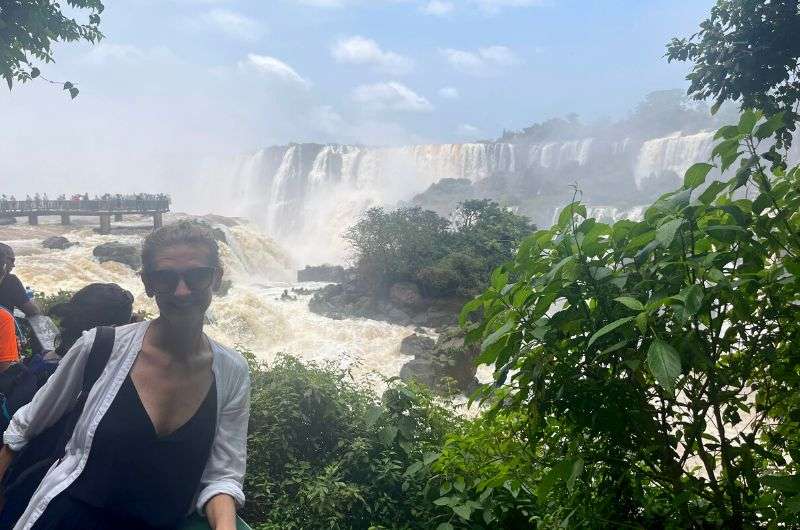
Let’s keep moving!
Main sites visited on day 3: Landmark of the 3 borders, La Casa de Botellas, La Aripuca, Jardín de los Picaflores
Restaurant tips: Jungle Restaurante–Puerto Iguazú (I'd love to recommend more fantastic restaurants, but unfortunately, we were just glad to find that one top-notch spot. Finding a good restaurant in Argentina is pretty much an oxymoron.)
Hotel recommendations: Loi Suites Iguazu Hotel
The third day is like a bonus, with the option to revisit Iguazu Falls for half a day. You'd probably want to head back to the Argentine side to explore some of the hikes I mentioned.
Or, you could try something called Jungle Fly, which is a set of fun activities for adrenaline junkies (read: lunatics). It includes trekking (which is cool), rappelling, and zip-lining. That day, we weren't planning to gamble with our lives at Iguazu Falls, so we gave the adrenaline-pumping trio a miss. After our hike, we decided to explore some other interesting and less perilous spots around the area.
Day 3, stop 1: Landmark of the 3 borders
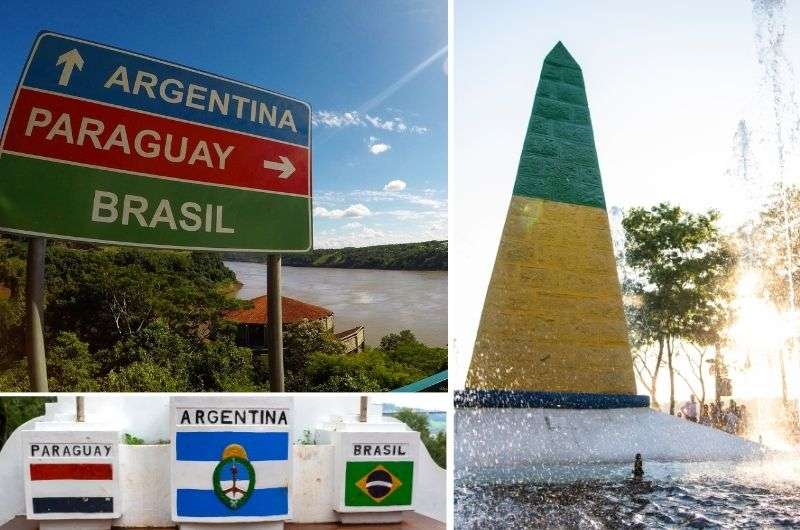
The 3 borders landmark and the Argentinean obelisk
Distance from hotel: 7.5 km (4.6 mi), 20-minute drive
Time spent there: 30 min
You've seen the falls from every angle and cardinal direction. Now it's time to check out the surrounding area, because the falls aren't the only draw here.
Right in Puerto Iguazú is a fascinating spot where the Brazilian, Argentinian, and Paraguayan borders meet. The actual border is right on the Paraná River, so there aren't any physical borders or customs checks here. If you're plotting an escape to another country, you'd better bring your swimsuit.
Each country has its own obelisk, painted in the colors of its flag. For Argentina, that means the obelisk is blue and white. Besides the obelisks, there are plenty of benches, making it a nice park to relax in. If you're after that quintessential tourist photo, there's a big blue frame ready for you. I've never really got the appeal of these frames—they're all over the place globally, and they don't strike me as particularly special or something I'd want to pose with. The view here is pretty nice, and the obelisks are cool. But beyond that, there's not much else of extraordinary interest.
Day 3, stop 2: La Casa de Botellas
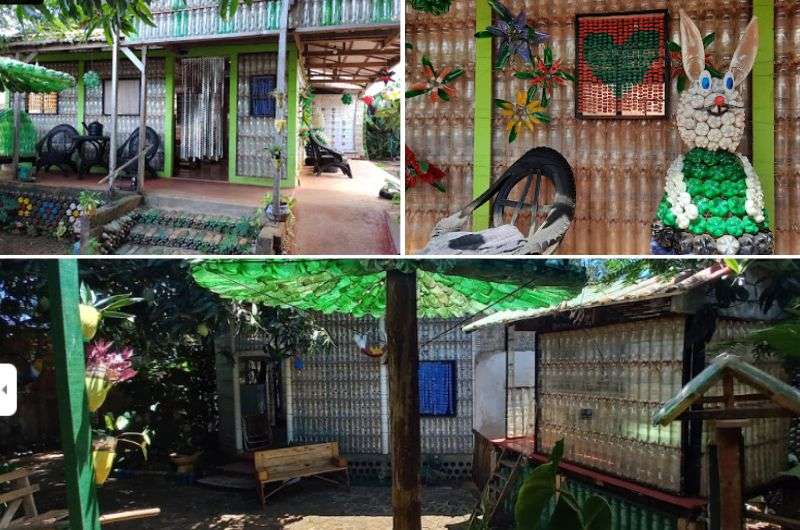
La Casa de Botellas
Distance from previous stop: 6 km (3.7 mi), 15-minute drive
Time spent there: 45 min
If you're an eco-enthusiast with a passion for recycling, La Casa de Botellas is right up your alley. This unique house is constructed from 1,200 plastic bottles and 1,300 tetra-pack containers, the annual waste output of an average family of four. I've never seen anything quite like it elsewhere.
During your visit, you'll even meet the architect behind this innovative abode, ready to field all your burning questions. The house's core mission is to show that it's entirely feasible to build houses from waste, giving it a second life. I think it's a brilliant concept. I'm baffled that it can stand upright.
Apart from the house itself, the entire interior is constructed from PET bottles and tetra-packs. You can even try lying on a bed made from PET bottles. By entering and purchasing souvenirs, you also contribute to the construction of similar houses for the needy in Argentina, Colombia, and Ecuador. This project isn't just a talking point; it's a life-changer, having already made a difference for 82 families. Now, whenever I toss out plastics and PET bottles, I catch myself wondering if I should build something out of them instead.
- Open daily 9 am–6:30 pm
- Tickets: ARS 4,000 (USD 5)
Day 3, stop 3: La Aripuca
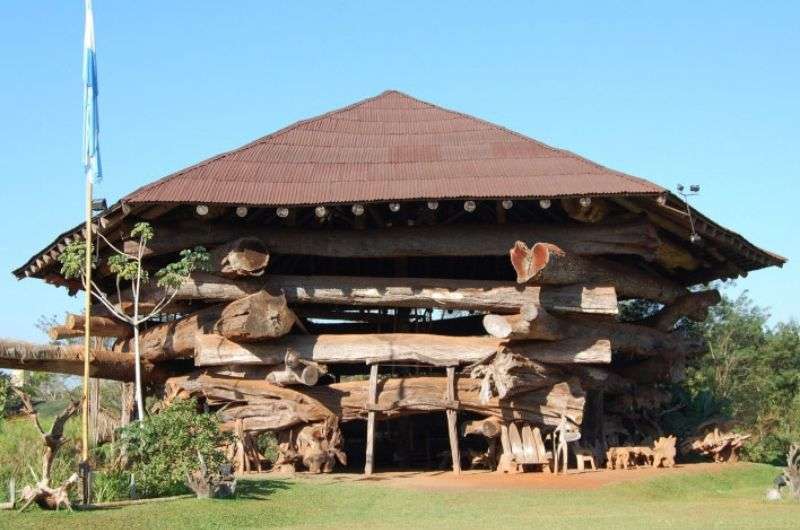
Distance from previous stop: 0.8 km (0.5 mi), 15-minute walk
Time spent there: 1 hour
La Aripuca is an educational center that's all about giving visitors a scoop on the local community and the wonders of nature. Its main attraction is a building named La Aripuca, a towering structure 17 meters (55.8 ft) high, built from 30 massive logs confiscated from illegal loggers, collectively weighing a whopping 500,000 kg (550 tons).
This isn't just any building; it's a monumental creation. The logs are arranged to resemble a traditional animal trap, but on such a grand scale, it looks more like it's meant for trapping giants.
And there's more to explore at the center: Tacurú, a shop selling handcrafted treasures from stones, Cucurucho, a cozy bar, Termitas, a restaurant offering local cuisine, and Yatei, a store showcasing regional products.
Each of these spots reflects the area's traditional architecture, giving you a taste of the region's history. Your ticket includes a guided tour packed with intriguing facts, and a part of your entrance fee goes towards saving the rainforests. Doing a good deed is always the right move.
- Official website
- Open daily 9 am–6 pm
Day 3, stop 4: Jardin de los Picaflores
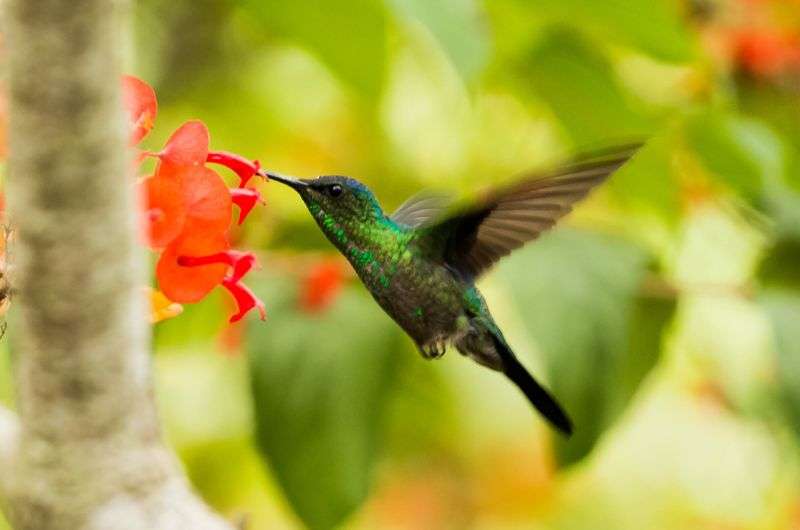
The Jardin de Los Picaflores is teeming with hummingbirds!
Distance from previous stop: 3 km (1.8 mi), 5-minute drive
Time spent there: 20 min
After the relentless noise and bustle at the waterfalls, it's high time for a slice of serenity to zen out a bit. The perfect spot for this is Jardin de Los Picaflores, a tranquil garden where hummingbird feeders filled with sugary water are dispersed, attracting the tiny, colorful birds.
My amateur eyes counted around ten different species. Interestingly, this garden is a labor of love by private individuals who wanted to invite more birds into their yard, turning their hobby into a hidden gem for visitors to enjoy.
The garden is not just about hummingbirds; it's adorned with an array of beautiful trees and flowers. Even if you're out of luck and the hummingbirds are elsewhere, you'll still leave with a memorable experience. If you find the garden gate closed, just ring the bell. The owners are usually there during opening hours, ready to welcome you into their little paradise.
- Open daily 4 pm–7 pm
- Tickets: ARS 3,000 (USD 3.5)
As you can see, your 3 days at Iguazu are full from start to finish. It’s truly an adventure you shouldn’t hesitate to take. I wasn’t 100% sure if Iguazu would be worth it, but oh boy am I glad we went! Make sure to see the falls from both sides—this can be done in 2 days if you are in a hurry.
And now, here are 12 Iguazu Falls FAQs that will help you when you’re planning your visit:
FAQ 1: What is the best time to visit Iguazu Falls?
Anytime's good for visiting Iguazu Falls, but I'm all in for visiting during the rainy season, from March to August. More water, more wow. Sure, you'll get drenched, but hey, you're heading to massive waterfalls, not a library! We hit the jackpot with our timing during the rainy season, as there was about 5x times more water than usual and you really want those levels of water, so plan accordingly. In the dry season it is still huge but you’ll get less falls and some dry rocks.
FAQ 2: Do you need to book Iguazu Falls in advance?
It all depends on which side you're entering the falls from. For the Argentine side, you need to buy your national park tickets in advance, but for the Brazilian side, you can get your tickets right there on the spot.
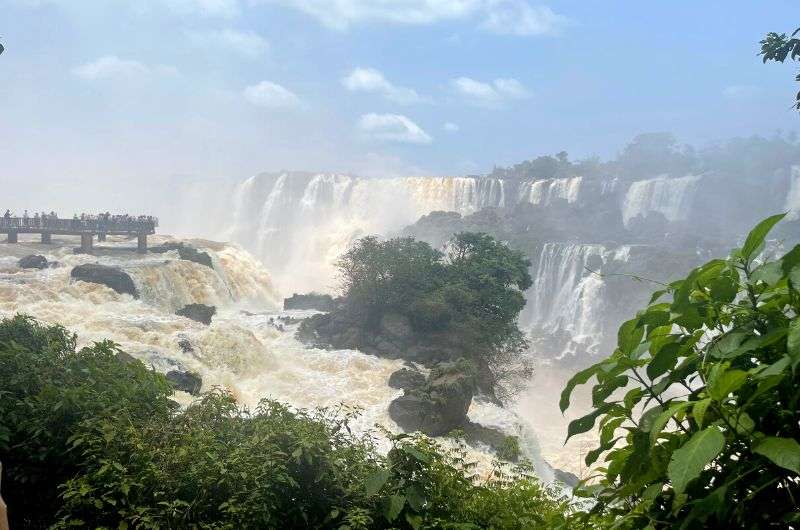
Warning: You need to book Argentina side tickets in advance!
When entering from the Brazilian side, you purchase tickets from machines at the entrance. If you want to skip the queues, you can also buy tickets online. You'll need to think about when you're heading to the falls because both ticket types are tied to a specific time. But if you're already there, it's expected you'll head straight in after buying your tickets. With online tickets, you'll need to plan a bit more to ensure you arrive at the entrance on time.
Why timed tickets, you ask? Well, it's all about the bus schedules. They'll herd you onto buses at the entrance and whisk you off to the falls. That's the only time you need to worry about; once you're at the falls, you've got the whole day to explore (well, until they close the park). The national park is open daily from 8 am to 6 pm on both sides.
For the Argentine side, tickets must be purchased online exclusively. The process is similar: choose your date and time, and a bus will take you to the falls to explore at your leisure.
FAQ 3: Does it cost money to go to Iguazu Falls?
Yes, entering Iguazu Falls, or more specifically, the Iguazu National Park, does come with a fee. It's ARS 20,000 (USD 24) from the Argentine side and BRL 100 (USD 20) from the Brazilian side. For the latest prices, I recommend checking the official websites.
Planning to visit the falls from both sides (which you totally should)? You can buy a discounted two- or three-day pass. And remember, you need to buy your tickets for the Argentine side in advance to avoid being stuck outside...
Here's a fun fact for you: Like in Turkey, there's a dual pricing system at Iguazu Falls. There's a more favorable rate for Brazilians and Argentines, and a higher one for tourists. Just a little something for amusement or a tip if you have dual citizenship, with one being Brazilian or Argentine, to save some bucks.
FAQ 4: Can you do Iguazu Falls in one day?
You can technically visit Iguazu Falls in a day, but it's a real shame to spend so little time there. I'm not usually a waterfall fanatic, but my jaw was practically on the floor the whole time I was there (3 days!).
Ideally, give yourself 3 to 4 days to explore the falls and the surroundings (4 if you want a more chill day to get some rest). Otherwise, you'll be rushing and miss out on what this natural wonder has to offer. I've laid out a whole 3-day itinerary above, so all you need to do is get some time off work and hit the road.
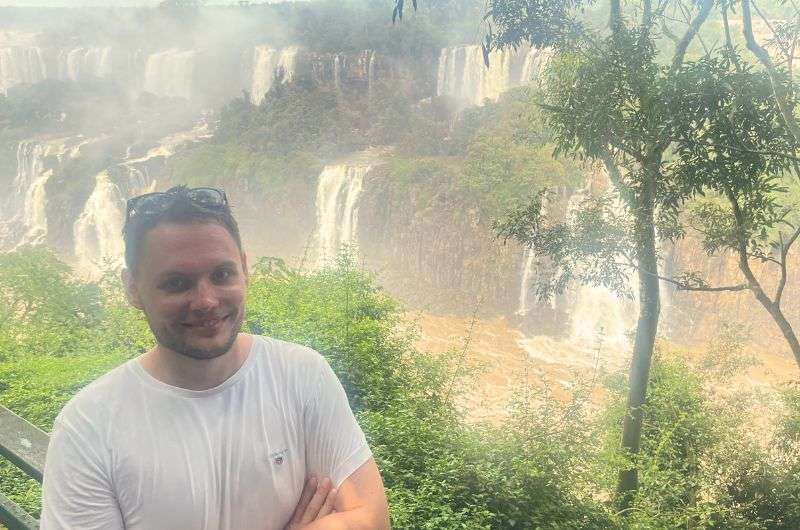
Iguazu Falls are huge! You're gonna take a good walk.
FAQ 5: How many days do you need in Iguazu?
The minimum number of days for Iguazu Falls, in my opinion, are two full days. You'll spend one day on the Argentine side and the other on the Brazilian side. If you have the time and don't want to rush, I'd comfortably spend 3 to 4 days there.
I've created a 3-day itinerary that'll have you covering all the must-see spots at Iguazu Falls... which, let's be honest, is pretty much everything. Yep, I've done all the planning for you, so just pack your bags and get going.
FAQ 6: Can you do Iguazu Falls without a tour?
Short answer, yes, you can absolutely visit Iguazu Falls on your own. Just grab your entry tickets to Iguaza National Park (refer back to FAQ 3) and off you go. Additional activities like the helicopter ride or boat tour can be purchased on-site.
Sorting things out on the spot is easier on the Brazilian side where everyone speaks English. That's a luxury you won't find in Argentina, so brace yourself.
FAQ 7: Should I stay on the Brazil or Argentina side of Iguazu Falls?
I would absolutely stay in Argentina as in terms of amenities it's pretty equal but it's cheaper and if you are traveling from Argentina also easier to fly to.
When it comes to visiting the falls, spend a day exploring from the Argentine side and another day from the Brazilian side, a quick 20-minute taxi ride away. You'll find all the juicy details in the itinerary.
We stayed at Loi Suites Iguazu Hotel, which boasts a fantastic location near the airport. It's like a giant complex nestled in a nature reserve with stunning pools and a river view. You genuinely feel like you're in the middle of the forest, yet there's free Wi-Fi everywhere. Someone really thought things through when they built this hotel (a rarity, I must say) because you've got all kinds of power outlets in the room, and, at night, you're not bombarded by any annoying lights.
The breakfasts are so good my girlfriend tried to create the jammiest cheesecake by layering on tons of jam. Besides breakfast, they serve fantastic drinks (hello, Caipirinha) by the pool, both tasty and affordable. The only downsides? A grumpy lady in the spa and a slightly small, under-equipped gym. But hey, the canopy bridges here are super cool, and you probably won’t have time for a workout anyway.
Note: The hotel is 10 km (6.2 mi) from the falls, yet you can still hear them! So, if you fancy drifting off to the sound of cascading water, this is your spot. Interestingly, the clientele is mostly older folks—classic America, the only group that still has money to travel, it seems.
FAQ 8: Do I need a car in Iguazu?
I can’t believe I’m about to say this, but no, you don’t need a car in Iguazu. It's very compact and it seems like a lot of hassle to cross the border in your own vehicle. So just go by taxi, they are very cheap.
My taxi tip: Always hop into a new cab once you need it. Don't get tied down with one driver for the whole day. You can negotiate better rates, and there's never a shortage of taxis, so no worries about waiting ages for a ride.
FAQ 9: Is the Iguazu Falls helicopter tour worth it?
The short answer is hell yes! The helicopter ride is absolutely fantastic, giving you a bird's-eye view you couldn't even get with a drone. A chopper over Iguazu Falls costs BRL 610 (approximately USD 145) per person for a 10-minute flight. The price might seem a bit steep, but the experience is totally worth it.
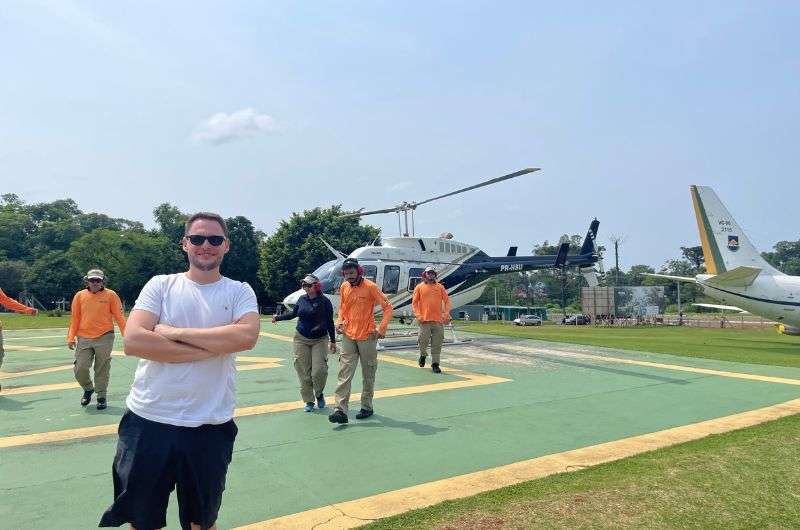
Totally worth it!
If you want to experience the helicopter ride, you'll need to visit the falls from the Brazilian side, as that's where the flights are operated from. The good news is that you don't need to book the flight in advance or go through a travel agency. If you happen to catch really bad weather, you simply won't fly that day. To buy a flight, just show up at Helisul (the company that organizes the flights), pay, sit down, and wait your turn. Then, just fly and enjoy it to the fullest.
Everyone speaks perfect English, which is quite refreshing. You'll also get a nice manual with safety instructions. You can pay in cash in dollars, which is quite convenient. The helicopter seats 6, and my advice is to board first or last. That way, you'll get a window seat, and a window seat means the best views.
FAQ 10: How do you get to Iguazu Falls?
Iguazu Falls is situated on the border between Argentina and Brazil, so it depends on which side you want to stay on and which airport you can find the best flight to. On the Argentine side, the nearest airport is Cataratas del Iguazu International Airport in Puerto Iguazú. On the Brazilian side, the nearest airport is Foz do Iguaçu Airport in the city of the same name. But overall, it doesn’t matter which airport you choose, as they are 45 minutes apart by car. I would decide based on which airport has the flight that fits your schedule best.
FAQ 11: How to get to Iguazu Falls from Buenos Aires, Argentina?
To get to Iguazu Falls from Buenos Aires, fly from Buenos Aires to Foz do Iguacu, it takes about an hour. And then just take a taxi or a shuttle to take you to whichever resort.
Or you can fly there from Salta or other big cities in Argentina or Brazil. I would consider it very easy to get there with many daily flights.
Tip: Speaking of Salta, the Salta and Jujuy region is definitely another destination you should visit in Argentina. Check out the top 11 things to see in Salta & Jujuy.
FAQ 12: How to get to Iguazu Falls from Rio de Janeiro?
The simplest way to get to Iguazu Falls from Rio de Janeiro is by air (surprisingly). Fly to Foz do Iguaçu; the flight is a lovely two hours. Then take a taxi to your hotel. If you follow my recommendation and stay at Loi Suites Iguazu Hotel, the taxi ride from the airport will only take 30 minutes.
This post contains affiliate links. I earn a small commission if you make bookings through my links, at no additional cost to you. Thank you for your support!


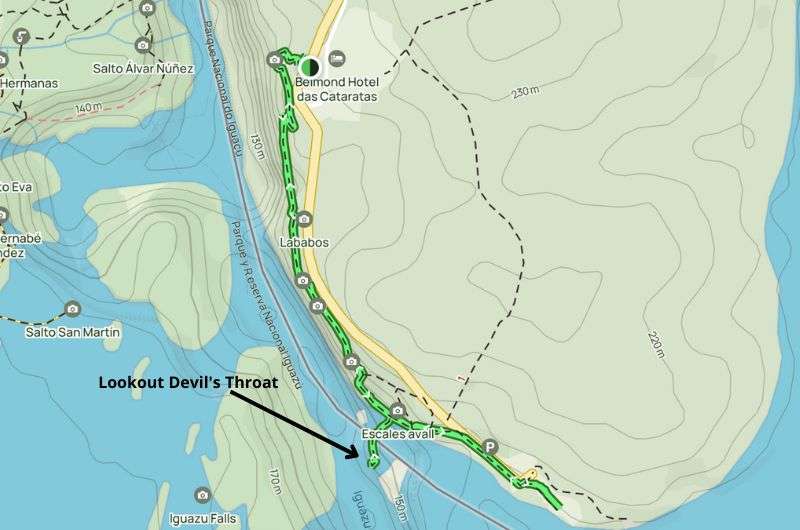
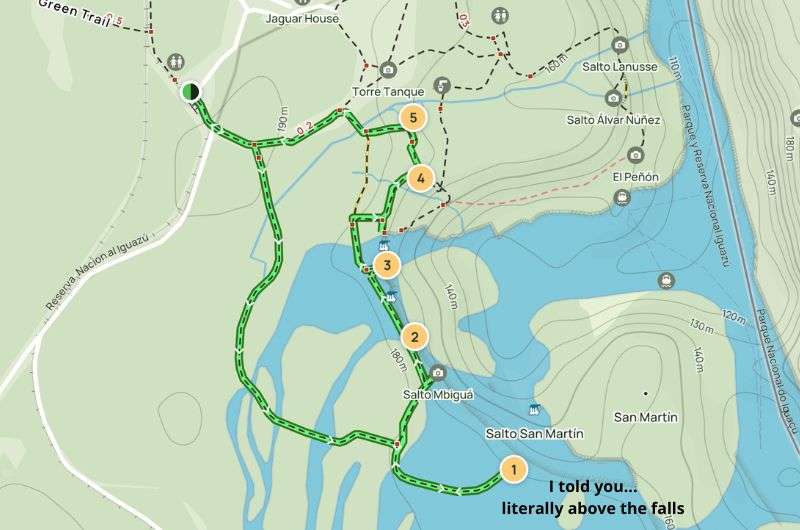
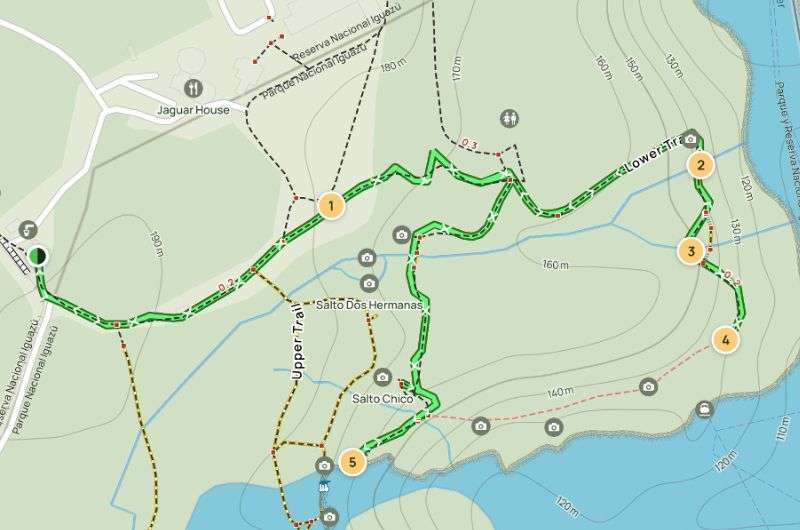

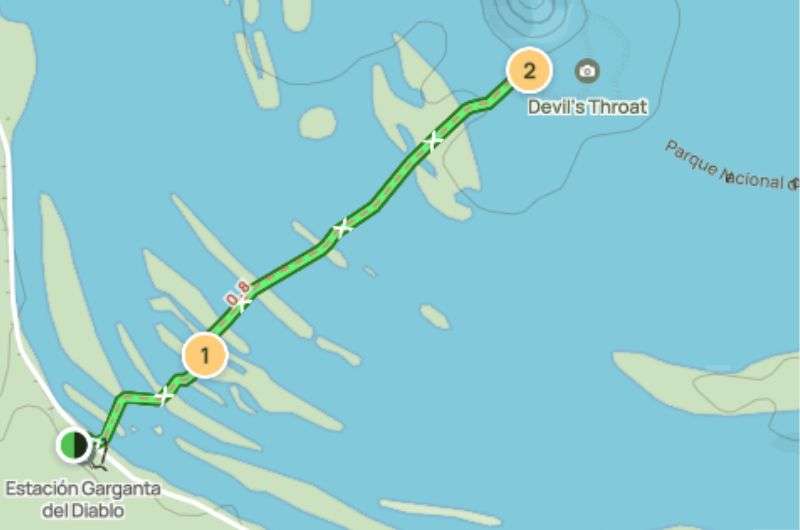
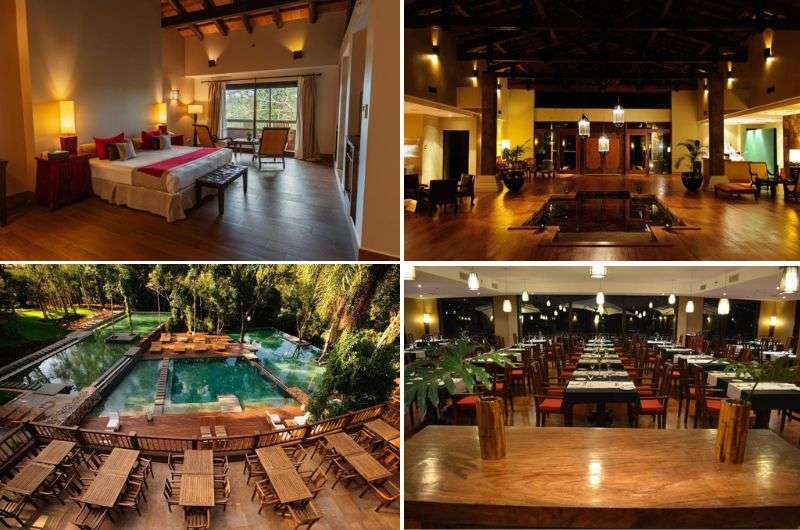
Comments | Thoughts? Give us a shout!
Recommended articles
Los Glaciares National Park is a hiker's paradise and giving it anything less than 7 days is bonkers. This spot needs to be at the top of your bucket list.
Patagonia is one of the most beautiful places in the world. I have seen plenty of incredible destinations on this Earth, but once you’ve visited Patagonia, it’s like you’re a different person. On my list, you'll find a total of 15 hikes, with 9 in Chile and 6 in Argentina.
I put Salta and Jujuy into my itinerary as an add-on since I didn’t want to see all the highlights in Argentina on my first visit. Well, that was a fail—Salta and Jujuy are world-class in natural sightseeing!
About me
Hi, I’m Jan. I travel fast and intensely, whether I’m exploring the buzz of Tokyo in 3 days or road-tripping through mountains and beaches on a 3-week Thailand adventure. And no matter where I am, you’ll always find me in a comfortable hotel at night and eating the best food.
If that sounds like your kind of journey, hop on board, and let’s explore the world together!
I started this blog after realizing how tough it can be to find reliable, authentic travel info. You wouldn’t believe how many “travel bloggers” never even visit the places they write about! On Next Level of Travel, you can count on my full honesty and insights drawn from my firsthand experiences.
More about meHere’s the deal: not every destination is all superlatives and unicorns. I’ll let you know if a tourist attraction isn’t worth your time, like skipping overrated stops in my 2-week Spain itinerary. And when I find something truly special—like the perfect mix of culture and nature in Cape Town—you can trust that it’s worth adding to your itinerary.
Next Level of Travel s.r.o.
ID: CZ07036612
Adress: Voctářova 2449/5, Praha, Czech Republic
Created by myTimi